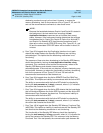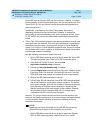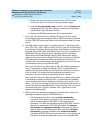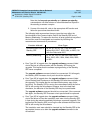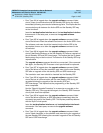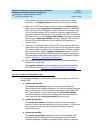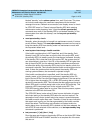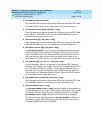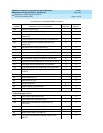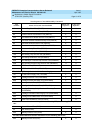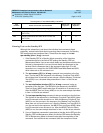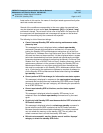
DEFINITY Enterprise Communications Server Release 5
Maintenance and Test for R5vs/si
555-230-123
Issue 1
April 1997
Maintenance Object Repair Procedures
Page 10-1270STBY-SPE (Standby SPE)
10
labeled "standby" on the status system form, wait 20 minutes. This does
not include cases where the command completes with the terminal
message line errors "Refresh not successful; use ‘display errors’ to check
for STBY-SPE errors" or "Cannot interrupt Standby SPE while entering
maintenance mode; please try later". Issue the refresh spe-standby
command once more. If the Standby SPE is not labeled "standby" on the
status system form after this attempt, use the busyout spe-standby
command.
■ reset spe-standby <level>
Normally, when the standby is brought into maintenance mode, it is done
so with a Warm Restart. The reset spe-standby command can be used to
bring the standby SPE from standby mode into maintenance mode with
the requested restart level.
■ reset system-interchange <health-override>
If the health-override option is NOT specified, and if the standby Fault
Severity Level (FSL) is less than or equal to that of the active SPE, and if
the standby SPE is in standby mode, the interchange is allowed. Actually,
if the standby FSL is less than that of the active FSL, the system does its
own interchange in due time. If the FSL of the standby SPE is higher than
that of the active SPE, but the alarmed standby maintenance objects do
not affect the ability of the standby SPE to be put into standby mode, the
command is rejected. This indicates that the health-override option can be
used. If there are problems that would prevent the standby SPE from
running system software, the command is rejected outright.
If the health-override option is specified, and if the standby SPE is in
standby mode, a Hot interchange is performed, regardless of the FSL
level of the two SPEs. Once the interchange is performed, if the new active
FSL is higher than the standby FSL, a STBY-SPE warning alarm is raised
against the new standby SPE. This indicates that the system was forced to
switch SPEs and is currently being held on the active SPE artificially. This
prevents a SPE interchange back to the original active SPE. This
STBY-SPE warning alarm lasts for one hour. After this time passes, system
switches to the SPE with the lowest FSL.
The STBY-SPE alarm is also retired if there is some indication of system
technician testing of the standby SPE before the one hour expires. The
assumption here is that a system technician person is present because
the health-override option was used. Therefore, if there is some indication
that repair work is going on, the alarm generated by the health-override
should be retired. The following are indications of system technician
testing being done: the standby SPE is busied out and then released, the
active SPE is hard selected via the switches, or a test spe-standby long
command is performed.
■ test processor [1] a|b [short | long]
Runs the same set of tests on the standby SPE as on the Active SPE. Refer
to the PROCR-BD and PR-MAINT sections for a complete list of the tests
that are run.




